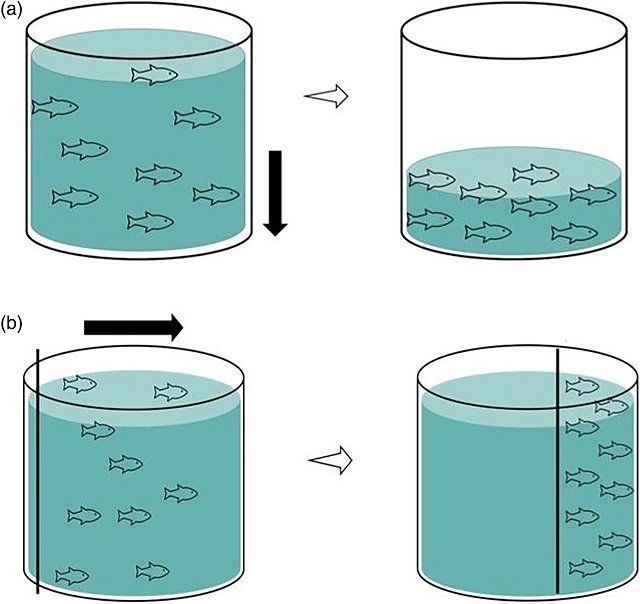
The way Nile tilapia (Oreochromis niloticus) is handled before slaughter significantly affects the final quality of the fillets purchased in the market.
A recent study led by scientists from the Universidade Federal da Grande Dourados investigated how pre-slaughter density (crowding) and stunning methods influence the quality and sensory characteristics of tilapia fillets.
Stress and the Fishy Equation
Studies reveal a clear link between pre-slaughter stress and fish quality. Stress triggers physiological changes that affect the flavor, texture, and overall quality of the final product. Here’s how:
- Stressful Journeys: Transporting fish can be stressful due to increased physical activity. An adequate rest period before slaughter is crucial to allow them to recover.
- The Big Chill versus Lack of Air: Stunning methods such as thermonarcosis (cooling) and asphyxiation can affect the fish’s energy reserves.
- Rising Stress Hormones: Environmental changes trigger a stress response, leading to elevated levels of cortisol, glucose, and chloride in the fish’s bloodstream. This alters the natural onset of rigor mortis, a critical stage in muscle stiffening post-slaughter.
The Domino Effect of Stress
These biochemical changes translate into a decline in fillet quality:
- Broken Tissue: Stress can cause ruptures in connective and muscle tissues, affecting texture.
- Color Concerns: Stress can alter the final color of the fillet.
- Dryness and Toughness: Stress can reduce juiciness and tenderness.
- Shorter Shelf Life: Stress can decrease water-holding capacity, affecting the fillet’s shelf life.
The Experiment
Researchers used fish with an average weight of 762 grams and divided them into four groups based on:
- Low density (50 kg/m³) with thermonarcosis stunning (gradual temperature increase).
- Low density with asphyxiation stunning (lack of oxygen).
- High density (300 kg/m³) with thermonarcosis stunning.
- High density with asphyxiation stunning.
Each group included 15 fish, for a total of 75 fish studied.
Subsequently, they analyzed various aspects of the fish, including:
- Blood Gases and Biochemical Parameters: These measurements evaluate stress levels and how the fish coped with pre-slaughter conditions.
- Muscle Injury Parameters: These tests assess muscle tissue damage, which can affect texture and quality.
- Meat Quality: This analysis determines factors such as firmness and cooking loss.
- Sensory Analysis: This involves trained individuals evaluating the taste and other sensory aspects of cooked fillets.
Key Results
The study revealed that high density (300 kg/m³) combined with asphyxiation stunning resulted in:
Stay Always Informed
Join our communities to instantly receive the most important news, reports, and analysis from the aquaculture industry.
- Increased Stress: The fish showed higher levels of blood gas parameters and biochemical markers associated with stress.
- Muscle Damage: Creatine kinase (CK) and its isoenzyme (CK-MB), indicators of muscle damage, were elevated.
- Lower Quality: The fillets exhibited softer texture, greater cooking weight loss, and potentially altered flavor according to sensory analysis.
Conversely, lower density (50 kg/m³) with thermonarcosis stunning caused:
- Reduced Stress: The fish exhibited lower stress markers.
- Less Muscle Damage: Creatine kinase levels were lower, indicating healthier muscle tissue.
- Higher Quality: The fillets had a firmer texture, less cooking loss, and potentially a more desirable sensory profile.
Impact on Tilapia Processing
Understanding how pre-slaughter practices impact tilapia quality is crucial. Producers prioritizing fish welfare and high-quality fillets are likely to opt for lower stocking densities and humane stunning methods like thermonarcosis. This translates to better texture, potentially enhanced flavor, and overall higher-quality tilapia for consumers.
Conclusion
By reducing pre-slaughter crowding and using thermonarcosis stunning, fish producers can minimize tilapia stress, resulting in fillets with better texture, potentially improved flavor, and lower cooking losses. This translates to a higher-quality product for consumers.
This study highlights the importance of proper handling practices to maintain tilapia quality. Further research could explore the optimal temperature and duration of thermonarcosis for tilapia stunning and the economic feasibility of implementing these practices on a larger scale.
Contact
Silvia Prestes dos Santos
Faculdade de Ciências Agrárias, Universidade Federal da Grande Dourados
Dourados, MS, Brazil
Email: silviaprestesmedv@gmail.com
Reference (open access)
Prestes dos Santos S, da Silva MI, Godoy AC, De Almeida Banhara DG, Goes MD, Souza dos Reis Goes E, et al. (2024) Respiratory and muscular effort during pre-slaughter stress affect Nile tilapia fillet quality. PLoS ONE 19(7): e0306880. https://doi.org/10.1371/journal.pone.0306880
Editor at the digital magazine AquaHoy. He holds a degree in Aquaculture Biology from the National University of Santa (UNS) and a Master’s degree in Science and Innovation Management from the Polytechnic University of Valencia, with postgraduate diplomas in Business Innovation and Innovation Management. He possesses extensive experience in the aquaculture and fisheries sector, having led the Fisheries Innovation Unit of the National Program for Innovation in Fisheries and Aquaculture (PNIPA). He has served as a senior consultant in technology watch, an innovation project formulator and advisor, and a lecturer at UNS. He is a member of the Peruvian College of Biologists and was recognized by the World Aquaculture Society (WAS) in 2016 for his contribution to aquaculture.




